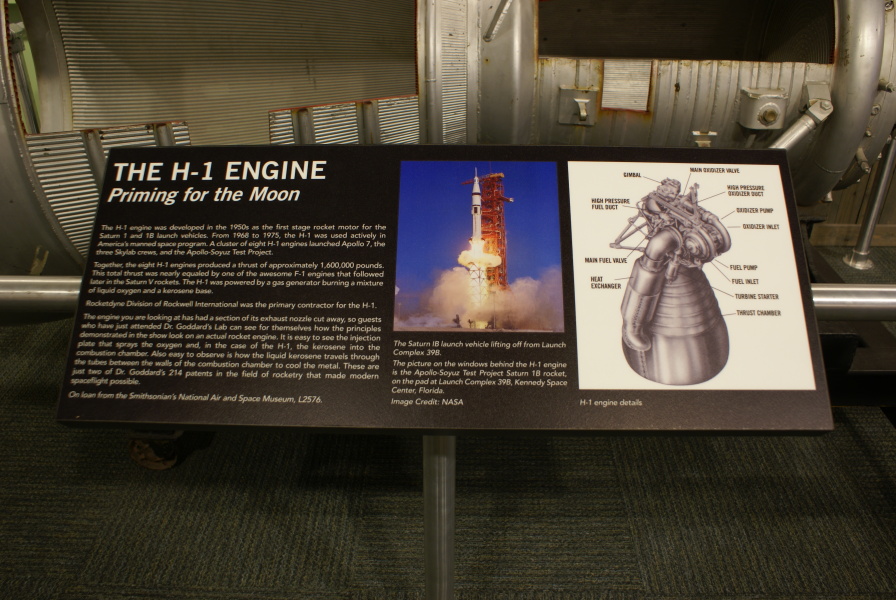| Prev |
heroicrelics.org Kansas Cosmosphere Site Index Cut-Away H-1 Engine Gallery |
Next |
dsc98929.jpg
The sign accompanying the H-1 engine. It reads
The H-1 Engine
Priming for the Moon
The H-1 engine was developed in the 1950s as the first stage rocket motor for the Saturn I and IB launch vehicles. From 1968 to 1975, the H-1 was used actively in America's manned space program. A cluster of eight H-1 engines launched Apollo 7, the three Skylab crews, and the Apollo-Soyuz Test Project.
Together, the eight H-1 engines produced a thrust of approximately 1,600,000 pounds. This total thrust was nearly equalled by one of the awesome F-1 engines that followed later in the Saturn V rockets. The H-1 was powered by a gas generator burning a mixture of liquid oxygen and a kerosene base.
Rocketdyne Division of Rockwell International was the primary contractor for the H-1.
The engine you are looking at has had a section of its exhaust nozzle cut away, so guests who have just attended Dr. Goddard's Lab can see for themselves how the principles demonstrated in the show look on an actual rocket engine. It is easy to see the ignition plate that sprays the oxygen and, in the case of the H-1, the kerosene into the combustion chamber. Also easy to observe is how the liquid kerosene travels through the tubes between the walls of the combustion chamber to cool the metal. These are just two of Dr. Goddard's 214 patents in the field of rocketry that made modern spaceflight possible.
On loan from the Smithsonian's National Air and Space Museum, L2576.
The H-1 engine initially produced 165,000 pounds of thrust, but the thrust was uprated incrementally during successive engine blocks to 188,000 lbs (starting with engines delivered February 12, 1962), 200,000 lbs (March 31, 1964), and finally 205,000 lbs (October 21, 1965).
Strictly speaking, Rocketdyne was a division of North American Aviation until the merger with Rockwell in 1967; the resulting company was initially known as North American Rockwell before another merger in 1973 resulted in the name "Rockwell International."
From mid-1962 until early 1968, Rocketdyne produced H-1 rocket engines (along with the S-3D engines used by Thor and Jupiter and the LR-89 Atlas booster engines) at its Neosho, Missouri plant. Rocketdyne manufactured research and development engines at its Canoga Park facility, as well as production engines prior to and after the production run at Neosho. Rocketdyne delivered its first production engine to the ABMA on April 28, 1959, and delivery of production engines continued until September 1968.
The accompanying diagram calls out the following H-1 engine components:
- Gimbal
- High Pressure Fuel Duct
- Main Fuel Valve
- Heat Exchanger
- Main Oxidizer Valve
- High Pressure Oxidizer Duct
- Oxidizer Pump
- Oxidizer Inlet
- Fuel Pump
- Fuel Inlet
- Turbine Starter
- Thrust Chamber
This cut-away H-1 is NASM catalog #A19700285000.

| Time picture taken | Fri Dec 6 11:00:14 2013 |
| Location picture taken |
Outside Dr. Goddard's Lab Kansas Cosmosphere Hutchinson, KS |
| Prev |
heroicrelics.org Kansas Cosmosphere Site Index Cut-Away H-1 Engine Gallery |
Next |